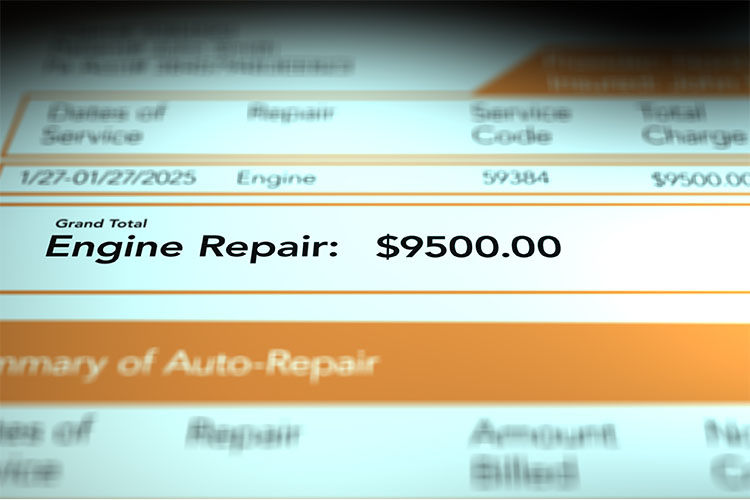Trump's 25% Trucking Tariffs: The Devil is in the Details


Trump's 25% Trucking Tariffs: The Devil is in the Details
All too often, the announcement of new government mandates and policies causes indigestion among business professionals. Part of the reason being the state of limbo between the announcement and the implementation of the policy. President Trump’s announcement of a new 25% tariff on heavy-duty trucks falls squarely into the indigestion-inducing category.
What is Trump’s 25% Tariff on Heavy-Duty Trucks?
In April 2025, the Department of Commerce (DOC) launched an official investigation into the effects of medium- and heavy-duty truck and truck part imports on national security. The result is a 25% tariff on imported commercial trucks. Determining exactly which trucks will be included is a somewhat murky matter, as announcements of the tariff have been made via two posts on President Donald Trump’s personal Truth Social media account rather than through any agency channels.
The first post, on September 25, 2025, trumpeted a tariff on all “Heavy (Big!) Trucks” made outside the United States, with implementation set for October 1, 2025.

Then, on October 6, 2025, Trump posted again, without preamble or explanation. According to his second social media post, the scope of the tariff included “...Medium and Heavy-Duty trucks…” and would take effect November 1, 2025.

Apparently, the stakeholders involved have had much to say about the tariff propositions, but will have to wait for official regulations issued by the DOC to receive the final word on exactly which classes will be included in the tariff and which, if any, other tariffs will be compounded.
Which Truck Brands Will Be Affected by the Truck Tariff?
Daimler, Freightliner, Western Star, PACCAR, Kenworth, Peterbilt, Navistar, International, Volvo, Mack, Isuzu, Hino, DINA, MAN SE, Scania, Mercedes-Benz, Cummins, Detroit Diesel, VW Buses, and emerging Asian brands such as Foton and Shacman all share varying degrees of exposure to the language of the announcement and thus risk of its effects. This is where the devil is in the details of implementation—which have not yet been clarified.
Although American brands account for the vast majority of HD trucks on the road in the U.S., much of the assembly is done in Mexico, and to a much lesser extent, in Canada.
Consider these key OEMs with heavy truck assembly in Mexico:
- Daimler Trucks North America (Freightliner, Western Star): Saltillo, Coahuila; Santiago Tianguistenco
- PACCAR (Kenworth, Peterbilt): Mexicali, Baja California, Monterrey, Nuevo León
- Navistar (International): Escobedo, Nuevo León
- Volvo Group (Volvo, Mack): New $700M facility in Monterrey, operational in 2026
- Isuzu, Hino, DINA, MAN SE, Scania, Mercedes-Benz, Cummins, Detroit Diesel, VW Buses, and emerging Asian brands (Foton, Shacman)
The biggest concern for these brands is whether the new tariff will be applied to trucks that are comprised of American-made parts, but are assembled in Mexico or Canada, making them “finished in a foreign country” and thus an import. Hopefully, agencies tasked with interpreting and administering the policy feel an urgency for clarification ASAP.
Will Trucks Made with American-Made Parts be Affected by Trump’s 25% Tariff?
The impact of Trump’s HD Truck Tariff on American truck brands that are assembled in Mexico and Canada is not yet known. Still, there may be relief in the form of the United States-Mexico-Canada Agreement (USMCA), which replaced NAFTA. The outcome depends on the decisions made by the DOC.
Under the USMCA, vehicles assembled in Mexico or Canada can enter the U.S. duty-free (i.e., without a tariff) if they qualify under the enhanced rules of origin (ROO). These rules, much stricter than NAFTA, require:
- 75% regional value content (RVC) in passenger vehicles and light trucks
- 64% RVC for heavy trucks from July 2020, rising to 70% by 2027
- Minimum 70% North American steel and aluminum
- Labor Value Content (LVC) rules: 40-45% of the value must be added in supply chains paying at least $16/hour
- Strict technical procedures for certifying compliance, with alternatives and staging periods for gradual transition
If a Mexican or Canadian heavy-duty truck and its parts are certified to meet RVC, steel/aluminum, and labor requirements, it may eligible for zero-tariff treatment at U.S. customs. However, it is still possible for the tariff to be applied, regardless of USMCA eligibility, at least until disputes are resolved or policy is clarified through formal regulations.
Key Legal and Practical Points:
- While USMCA is the baseline for tariff-free trade, Section 232 allows the administration to override trade agreement obligations for “national security” reasons.
- Finished passenger cars assembled in Mexico, even if USMCA-compliant, have recently faced new tariffs (on top of USMCA rates).
- Large portions of the trucking industry and legal experts expect the same to happen here, as confirmed by supply chain academics.
What Impact Will Trump’s Heavy-Duty Truck Tariff Have on Fleet Operators, Independent Truckers, and Downstream Supply Chains?
If the new truck tariff overrides USMCA policies, the end-user impact will be immediate and severe.
In a recent Transport Topics article, the American Trucking Association estimates that the 25% tariff will be compounded when the federal excise tax (FET) of 12% is applied to the new, higher base, resulting in an average out-the-door price of roughly $224,000 per truck for tariff-affected units.
Fleet operators, squeezed for margins and often unable to pass along higher truck costs, will be forced to extend trade-in cycles, delay replacement, and prioritize repairs on older vehicles. Many will front-load purchases pre-tariff, temporarily spiking demand but depleting dealer inventory, followed by a sharp procurement slowdown.
Independent owner-operators and small fleets, who often lack access to volume discounts or flexible capital, face the risk of being priced out of new equipment purchases entirely. This limits their ability to comply with regulatory mandates for emissions and safety, disproportionately affecting the most cost-sensitive segment of the industry.
Supply chain and equipment availability will experience complex adverse effects:
- Lead times: OEMs reliant on Mexican output will likely see extended lead times for U.S. buyers, as capacity is reallocated and U.S. production ramps up (if it ramps up at all).
- Used truck market: With new units in short supply and at inflated prices, late-model used truck values are expected to trend upward, leading to increased resale prices.
- Parts and maintenance: If component tariffs are enforced on cross-border parts, all North American fleets will experience higher repair and maintenance costs, jeopardizing uptime and parts availability—particularly for fleets running older iron.
- Contract rates for shippers may eventually rise, especially for tariff-impacted service lanes or sub-sectors that rely on new equipment and guaranteed uptime.
Strategic Takeaways for End Users
For fleet operators, procurement and maintenance teams, and independent truckers, this new tariff presents a strategic and practical challenge. Understanding how it affects your sourcing, pricing, and uptime is essential for staying competitive and avoiding costly surprises.
Tips to help manage the uncertainty include:
- Expect price volatility for imported models.
- Prioritize North American-built trucks with verified exemption status.
- Monitor OEM announcements for production shifts and sourcing updates.
- Prepare for customs delays even if trucks are exempt.
By taking proactive steps now, fleet buyers and operators can minimize disruption, protect margins, and make smarter decisions in a rapidly evolving supply landscape.
 About the author: Ryan E. Day is a communications specialist at Work Truck Solutions, where he turns complex ideas into engaging content that drives business impact across industries and platforms. With 13 years of experience in B2B content marketing, Ryan specializes in storytelling, strategic messaging, and digital optimization.
About the author: Ryan E. Day is a communications specialist at Work Truck Solutions, where he turns complex ideas into engaging content that drives business impact across industries and platforms. With 13 years of experience in B2B content marketing, Ryan specializes in storytelling, strategic messaging, and digital optimization.
Ryan's work has been featured in Comvoy, Quality Digest, Youtube, and Amazon Kindle. Connect with Ryan on his Linkedin page.
 Best Gifts for Truck Drivers and Truck Owners (2025 Guide)
Best Gifts for Truck Drivers and Truck Owners (2025 Guide) Aftermarket Warranties for Commercial Vehicles: Mitigating Downtime and Preserving Profits
Aftermarket Warranties for Commercial Vehicles: Mitigating Downtime and Preserving Profits 2026 Commercial Trucks and Vans: What’s New from Ford, GM, and Ram
2026 Commercial Trucks and Vans: What’s New from Ford, GM, and Ram New Commercial Vehicle Market Reflects Transitions in Q3 2025 Amid Pricing Adjustments and Inventory Realignment
New Commercial Vehicle Market Reflects Transitions in Q3 2025 Amid Pricing Adjustments and Inventory Realignment The Value of Work Ethic: Comvoy.com Promotes Mike Rowe's Work Ethic Scholarship Program
The Value of Work Ethic: Comvoy.com Promotes Mike Rowe's Work Ethic Scholarship Program







